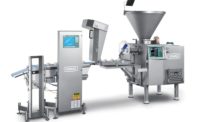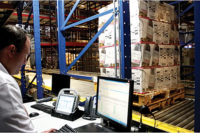Tray-packing equipment now offers even quicker changeover capabilities as well as enhanced automation and flexibility. Equipment designs are more compact so that machinery fits into tight floor spaces.
New tray-packing equipment features increased automation and flexibility, with compact designs that can fit into tight spaces. It also offers quick changeover capabilities, which help reduce material and labor costs. This is good news for bakers and snack producers who operate in a quick-changing marketplace.
“As upstream processes improve to accommodate more stock-keeping units (SKUs) and shorter production runs, tray-packing equipment needs to be equipped with fast or automated changeover, while being easy to operate and maintain,” says Barry Rinaldi, director of business development, Schneider Packaging Equipment Co. Inc., Brewerton, NY. “How quickly and reliably you can change over tray-packing equipment directly affects overall effectiveness.”
More bakers and snack food producers are concerned with packaging cost reduction and sustainability, according to Bryan Sinicrope, vice president, sales and marketing for A-B-C Packaging Machine Corp., Tarpon Springs, FL. “As far as cost reduction is concerned, bakery and snack food producers are looking for increased automation to reduce their labor costs,” he says. “In some cases, they’re looking at new package [structures] that reduce their material requirements. Their sustainability goals also typically involve
less packaging materials.”
Be retail-ready
Wayne Slaton, senior director of sales at Douglas Machine Inc., Alexandria, MN, sees more cookie trays in bags being loaded into retail-ready packages (RRP) for display. He also sees multiple orientations of cartons and pouches in cases and trays. For example, cased product packed flat (in a 2 x 6 x 1 configuration, for example) and trays require load rotations, so that packages are 2 x 1 x 6 across a tray.
“As far as the snack food market goes, we see more processors moving to the rigid ‘car cup’ package for busy, on-the-go consumers,” says Scott Cummings, regional sales manager at Reiser, Canton, MA. “This applies not only to dry snacks, but protein snacks as well. Not only does the processor gain shelf-life advantages, but the package facilitates ease of use for consumers.”
Consumer trends are driving these moves to increase automation and flexibility on the equipment side. The need to offer consumers more choices means bakers are shipping more products even farther from their manufacturing plants, which increases their tendency to pack trays of product into shipping cases for transport rather than in conventional bakery trays, according to manufacturers that supply the bakery and snack food market.
Retail-ready preparations for multiple marketing channels, ranging from big-box stores to convenience stores, are complicating the requirements for tray-packing lines. They are prompting equipment vendors to design more flexible equipment instead of machinery for single-purpose applications. The advent of both servo technology and servo changeover capabilities, robotic systems and the need for more flexible pouch-handling requirements are driving new machine developments.
Product/package evolutions
Consumer demands fueled in large part by 75 million millennials are also driving SKU diversification and proliferation. Portion sizes are accommodating the trend for healthier alternatives and gluten-free products, says Glenn Rindfleisch, bakery industry manager, Rehrig Pacific Co., Naples, FL. “As a result, primary, secondary and tertiary packaging changes are increasingly important factors in the commercial baked goods industry,” he says. “For example, many reusable plastic tray float designs used throughout the baking industry are being reconfigured to address new SKU size and weight requirements.”
There are challenges involved in designing tray-packing equipment for bakeries and snack food plants. Space availability is at a premium in-plant and increasing requirements for material handling (conveying, diverting and distribution) to end-of-line stations are challenges cited by many manufacturers.
“Reusable plastic packaging is increasingly sophisticated in both design and equipment interface,” says Rindfleisch. “In addition, equipment vendors face the challenge of handling multiple tray or pallet styles from multiple sources. As a result, Rehrig Pacific strives to develop consistent and repeatable, proprietary solutions.”
Bakers and snack producers look to Reiser’s experience in the modified-atmosphere tray sealer arena to guide them in the development of tray packaging, says Cummings. “We employ a team of packaging specialists to help our customers develop functional packages that will sell.”
New tray-packing equipment is also being designed and built to consider the new food-safety regulations and sustainability initiatives. “Our servo platforms have substantially improved sanitation characteristics over previous mechanical versions,” says Slaton of Douglas Machine.
ADCO Manufacturing, Sanger, CA, decided years ago to incorporate sanitary design into its tray-packing equipment, not only for washdown environments, but also for low-moisture foods and dry sanitation. “Every machine model we build employs key sanitary design principles, or they are easily modified to meet new standards as the standards emerge,” says Scott M. Reed, vice president of sales, marketing and customer service. “We also look for ways to reduce the power and air consumption requirements of our machinery.”
New systems
Among tray-packing equipment recently introduced to the marketplace is A-B-C’s Model 170 tray packer, which accumulates product and packs and seals trays automatically at speeds up to 25 trays per minute. The machine is 16.7 ft. long, making it easy to fit into most production line layouts. The steel frame’s tubular design provides strength while eliminating catchpoints for dust accumulation, which helps meet food-industry requirements.
All product-contact parts are made of stainless steel for smooth product handling and packaging protection, according to Sinicrope. “The low-level tray magazine is positioned for easy loading, and the high-capacity auxiliary section may be refilled at any time during operation,” he explains. “Trays are indexed from the stack top to ensure proper feeding of even warped or band-marked trays.”
Reiser recently launched its IN Series in-line tray-sealer line. Available in four models, the sealer produces modified atmosphere packaging (MAP) using preformed trays of various shapes and sizes. “The IN Series produces packages with high-quality seals that virtually eliminate leaks,” Cummings says. “It’s designed to allow rapid changeover between tray sizes in less than 10 minutes. Also, the stainless-steel washdown construction provides a high level of sanitation, and it has an intuitive HMI touchscreen controller to also facilitate operation.”
As bakeries and snack food plants face increasing demand to produce more SKUs on existing equipment, the need to improve line efficiency and reduce changeover time is paramount. Schneider Packaging Equipment recently introduced the ProAdjust to address the need for speed and accuracy, and it can be purchased with new tray-packing machines or added to existing equipment as a retrofit. ProAdjust is a self-contained, auto adjustment system that makes changeovers fully automatic, says Rinaldi.
ADCO Manufacturing recently introduced the EnCompass carton/case packer. This monobloc system erects, loads and closes top-loading paperboard cartons or corrugated regular slotted containers (RSCs) in a compact footprint. In addition, Delta robots (those that have three “arms” connected to universal joints at the base, with parallelograms in the arms that maintain the orientation of the end effector) provide maximum speed and flexibility in the carton/case loading operation, according to Reed.
ADCO also is releasing a robotic top-loading system that mates directly with its line of top-loading carton formers and sealers. “The RTL-2x features a twin-axis robot equipped with Allen-Bradley motion controls, so it’s capable of delivering high picking rates with few moving parts,” Reed notes. “Because it doesn’t utilize proprietary motion controls, it’s easier to program and operate. This top-loading system is suitable for the bakery and snack food market.”
With all of the challenges bakers and snack food producers face, they can now find an array of new developments for their changing tray-packing needs.









